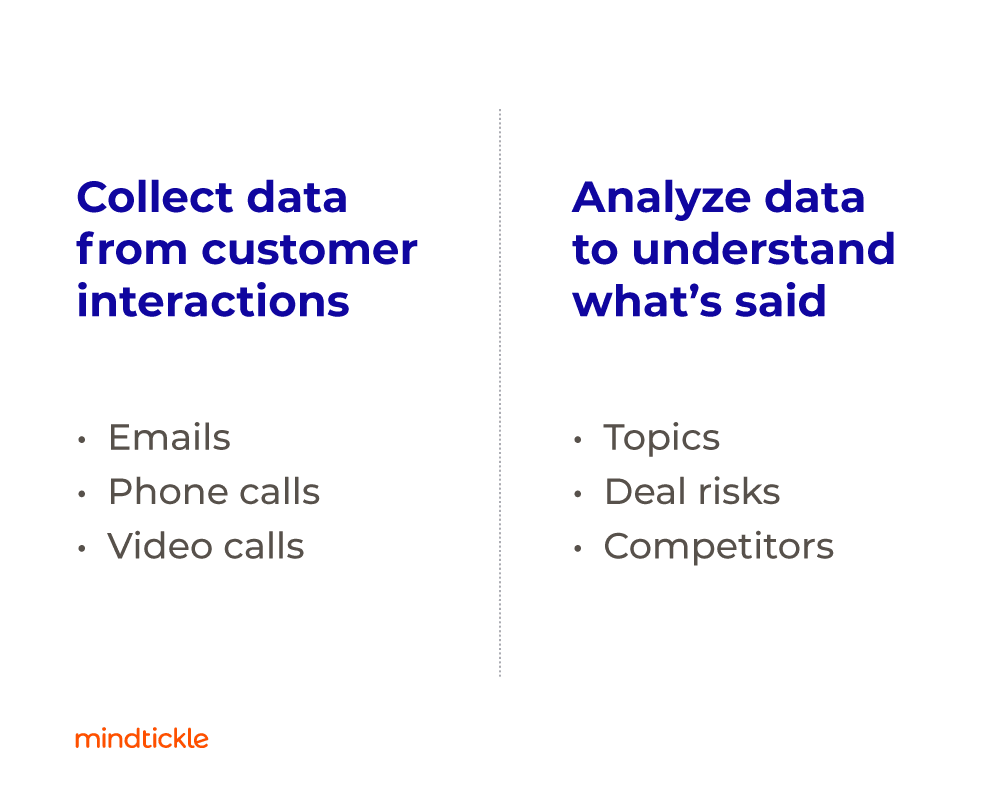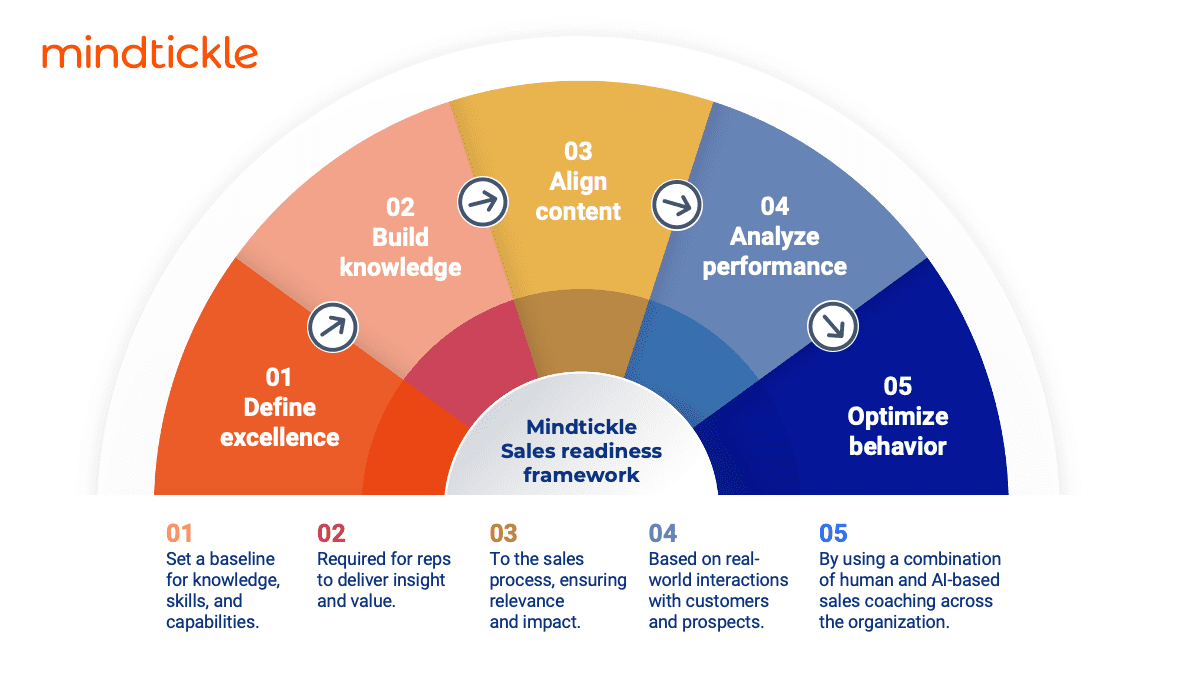The 4 Fundamentals of Revenue Intelligence That Actually Matter
Revenue intelligence sounds like a dream come true for any sales leader. Of course, you want more intelligence about how to predict and grow revenue. But is it the game-changer it sounds like? According to Salesforce, it’s simply “a data-driven way to sell [using] AI and automation to create visibility across the revenue lifecycle.”
Behind its shiny wrapper and market buzz, we’ve boiled down revenue intelligence into four fundamental elements that actually matter to sales teams.
1. Automate data entry to improve data quality
Revenue intelligence tools use AI and automation to reduce manual and repetitive tasks, such as data entry. The tools automatically collect data from every interaction your reps have with a prospect, such as call recordings and emails. This helps to improve the quality of data in your customer relationship management solution (CRM) as you’re not left with incomplete entries when your sales reps jump on another call before they finish updating their notes from the previous one.
The improved data quality then enables revenue intelligence tools to more accurately predict revenue growth based on the data from your past deal flow.
So far, so good — except sales forecasting is hardly a new concept. Capterra lists 199 sales forecasting tools so while improving the quality of data in your CRM is a worthwhile pursuit, a revenue intelligence tool isn’t the only option for achieving that outcome.
And looking at the big picture, there’s more at stake than just revenue. The tools you use should also support the needs of your reps and automating data entry is one way to help them improve productivity and get some usable time back in their day. Reps can spend more time on knowledge building, training, and coaching to ensure sales readiness. The less time reps spend entering data into your CRM, the more time they have to prepare for their next calls — equipped with the right content assets and ready for the conversation, whether they’re talking pricing or delivering a demo of your latest features.
2. Increase visibility into deal flow
Revenue intelligence tools are already capturing data from customer interactions This data can be analyzed to identify key terms and topics covered — such as product features or competitors — making it easier for sales reps, managers, and other team members to get greater visibility into their deal flow and how customer conversations are progressing.
But revenue intelligence tools aren’t the only way to get that level of visibility into your customer interactions. G2 lists 70 conversation intelligence tools that enable users to “identify keywords and topics of conversation so users can quickly jump to those points in the recorded sales calls and further analyze valuable insights.”

Increased visibility into customer interactions is a good thing for sales teams — but only if you look at the bigger picture and use the insights to improve your whole team’s performance. Revenue intelligence tools provide those insights on a deal-by-deal basis. But it’s more useful if you make conversation intelligence part of an overarching sales readiness framework and use those insights to provide your team with optimal training, content, and coaching. That way, your sales team can learn from each other’s experiences, plus follow established best practices, to improve overall performance.
3. Get real-time access to sales data
According to Oracle, entering data into the CRM was one of the top five complaints from sellers who are frustrated with the time-consuming elements of their jobs. As a result, fewer than half of sellers use their CRM daily. The manual, time-consuming nature of data entry means that more than half of reps don’t enter data from their sales conversations until the next day, at the earliest.
Revenue intelligence tools give sellers access to data from their sales conversations much sooner. Also, they analyze what’s being said in sales interactions as they happen, looking for key topics and messaging.
Sellers can quickly see what was discussed on their last call. Similarly, managers can listen to call recordings or review transcripts to identify signs of a rep going off message or missing key opportunities.
This sounds great — but what are you using that data for? Revenue intelligence tools allow you to identify the next best steps to move that particular deal forward. But sales interaction data can be better used to enable your sales team by helping them optimize behaviors to improve their overall performance.

The last two stages of Mindtickle’s Sales Readiness Framework enable sales teams to analyze their performance and optimize behavior. Our conversation intelligence tool, Call AI, analyzes sales data and uses those insights to deliver personalized, tailored training and coaching programs to your reps. In the long run, a more knowledgeable, informed, and skilled sales rep will be better prepared to handle complex selling situations and close more deals. Remember — it’s not the data that matters; it’s what you do with it.
4. Operate based on facts, not opinions
Revenue intelligence tools can help you make smarter decisions by giving you access to all your sales data, so you can act based on facts, not opinions. But often the focus is on gathering more and more data and assuming that insights will magically appear.
If your aim is to collect sales data, your reps have a lot of tools at their disposal, like your CRM, call transcripts, conversation intelligence tools — even the handwritten notes they make while on a call with a prospect. Sure, some of those aren’t automated, but you’re still collecting and recording data about your customer interactions and using that as the basis for deciding how best to move forward with the sales process.
![]()
You can collect all the data you want — but if your reps don’t know how to uncover useful insights to help them improve, it won’t make a difference to your bottom line.
What’s more important is developing a culture of continuous improvement for your sales team. Your sellers need to be able to interpret data and use it to move their deals forward. They also need to be able to learn from it — that conversation or customer email — and know how they do better next time. In the long run, that will have a bigger impact on your sales performance (and your revenue) than simply handing a load of data over to your reps and expecting actionable insights to materialize.
Revenue intelligence misses your sellers
What’s the top priority for sales orgs using revenue intelligence tools? The clue’s in the name — revenue. And while that’s likely true for your sales team, too, it’s your salespeople who are the real revenue drivers, not all your old sales data. All the revenue data in the world won’t change a thing unless you use it to empower your sales team.
Now that you understand what revenue intelligence really means and where its blind spots are, you can find tools that meet your team’s practical needs — for your people, not just your company’s bottom line. Look for platforms that use data to empower your sellers through enablement, training, and coaching to help them build the skills, knowledge, and behaviors to achieve sales excellence.
It’s time for sales organizations to put people before data as they’re the ones that bring in revenue.



